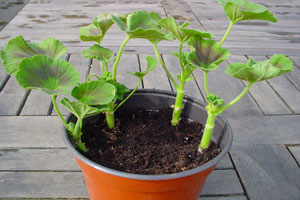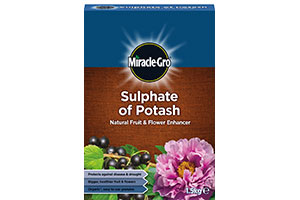August Garden Diary
 This month, our Garden Diary is courtesy of The ScottsMiracle-Gro Company and looks at work in your flower beds and borders, patio gardening and care of your lawn.
This month, our Garden Diary is courtesy of The ScottsMiracle-Gro Company and looks at work in your flower beds and borders, patio gardening and care of your lawn.
Although August is typically one of the warmest months of the year, with an average of six hours of sunshine every day, there can still be periods of rain. But it’s certainly a great month to enjoy the results of all that hard work earlier in the year.
Barbecues, al fresco dining, picking lots of tasty fruit and vegetables and just pottering around keeping the garden looking great are the rewards to enjoy to the full.
FLOWER BEDS & BORDERS
Cut back the old and damaged leaves of early summer-flowering perennials, such as geraniums and heucheras, to encourage a fresh flush of new, more attractive foliage. This will also keep the plants more compact and, with some plants, may also encourage a further flush of flowers.
Always give the plants a good liquid feed of either Miracle-Gro All Purpose Soluble Plant Food, Miracle-Gro All Purpose Concentrated Liquid Plant Food or Levington Tomorite after cutting back to ensure strong, healthy regrowth and, where relevant, new flowers.
 This is the best month to take cuttings of fuchsias, pelargoniums, trailing petunias, osteospermums and other half-hardy, perennial patio and container plants ready for overwintering for next year. If you leave it until autumn, the cuttings may not be large enough to come through the winter successfully.
This is the best month to take cuttings of fuchsias, pelargoniums, trailing petunias, osteospermums and other half-hardy, perennial patio and container plants ready for overwintering for next year. If you leave it until autumn, the cuttings may not be large enough to come through the winter successfully.
Choose strong, healthy young growth that isn’t flowering. If you can’t find suitable shoots, cut back hard one or two at the back of the plants to encourage strong regrowth.
Take cuttings 7.5-10cm (3-4in) long, cutting below a leaf joint, or node. Remove the leaves from the lower two-thirds of the stem and insert in pots of Levington Seed & Cutting Compost or Levington Original Multi Purpose Compost. Cover the pot with a plastic bag (except pelargoniums) or place in a propagator and place somewhere out of direct sunlight to root.
Buy winter and spring bedding plug plants and pot them up into 7.5-10cm (3-4in) pots of good potting compost, such as Miracle-Gro Potting Mix Root Boosting Compost or Levington Original Multi Purpose Compost. The sooner you get them started, the bigger the plants will be when you’re ready to plant out in the autumn. Small plants won’t give a good display, whereas well-established plants will provide a floral extravaganza.
Mulching borders with a 5-7.5cm (2-3in) thick layer of Miracle-Gro Moisture Control Decorative Pine Bark or Levington Water Saving Decorative Bark can help retain essential soil moisture and keep down the weeds.
If you have gaps in your beds and borders, it’s a good idea to plug them with some new plants. Garden centres will have lots of good-sized summer-flowering plants that you can pop in now for instant colour and interest.
Topical Tip
Start shopping for spring-flowering bulbs, placing orders with mail order specialists. The weather over the last year has been testing for bulb growers and bulb harvests have been badly affected. Bulbs may well be in short supply in autumn, so get your orders in now to avoid disappointment.
PATIO GARDENING
Summer container displays may be looking a bit tired now after flowering for so long – but they can still go on providing colour and interest for many weeks to come if they’re looked after properly.
It is essential to water containers frequently – especially hanging baskets, which are very prone to drying out. This could mean every day during warm, sunny and/or windy weather. The aim should be to try and keep the compost evenly moist; you can always test the compost by pushing your finger into it and feeling if it’s damp.
If you’re away from home for most of the day and especially when you go away for weekends or longer holidays, watering becomes a bit of a problem.
Installing a drip watering system and a battery-operated timer removes all the stress, as it does the watering for you!
Regular feeding with Miracle-Gro All Purpose Soluble Plant Food, Miracle-Gro All Purpose Concentrated Liquid Plant Food, Miracle-Gro LiquaFeed or Levington Tomorite will give your plants all the energy they need to provide fabulous displays.
Flowering plants should also be deadheaded regularly once the flowers begin to fade. Remember to remove the developing seed head or seedpod as well as the flower and your plants will continue flowering right up to the first frosts of autumn.
Topical tip
Standing containers that dry out very quickly in plant saucers topped up with water will help keep the compost moist for longer.
LAWNS
In order to keep your lawn beautiful for the rest of the summer it will need some TLC. Correct mowing and good feeding will be essential, as will controlling any weeds.
Don’t cut the grass too short – aim to keep it around 4cm (11/2in) high. Doing this weekly is quicker than mowing less frequently, as you’ll empty the grass box less often!
The grass will need feeding throughout summer. Whenever there are periods of prolonged dry weather, a liquid feed will be a better choice compared to a granular feed. Good choices include Miracle-Gro Water Soluble Lawn Food, EverGreen Spray & Feed Lawn Food or Miracle-Gro LiquaFeed Lush Lawn.
Single weeds can be dug out or spot treated with Verdone Extra Ready to Use. If weeds are a real problem, it would pay to treat the whole lawn with Verdone Extra.
As long as the soil isn’t bone dry, now’s the time to dig over areas you want to turn into a lawn in the autumn. Improving poor soil is important for good grass growth – and something many people don’t consider. While digging over the soil, add EverGreen Enriched Lawn Soil to ensure your new lawn gets off the best possible start. After digging over, leave the soil for a few weeks to allow weed seeds to germinate, then spray with a weedkiller, such as Weedol Rootkill Plus, or hoe them off. This will reduce weed competition when sowing a new lawn from seed.
Topical tip
Damaged edges should be repaired by cutting a new one with a half moon edging iron. Use a board or plank to get a good straight edge or use a hosepipe as a guide for curved edges.
TREES, SHRUBS, ROSES & CLIMBERS
This is the time to propagate a range of shrubs – such as ceanothus, choisya, hebe, hydrangea, lavender and philadelphus – from semi-ripe cuttings.
 Take cuttings 7.5-10cm (3-4in) long, cutting below a leaf joint, or node. Remove the leaves from the lower half to two-thirds of the stem, treat the cut end with hormone rooting powder or liquid and insert in pots filled with Levington Seed & Cutting Compost or Levington Original Multi Purpose Compost to the base of the lowest leaves. Place the pots in a cold frame, propagator or cover with a plastic bag and place them somewhere warm, but out of direct, burning sunlight.
Take cuttings 7.5-10cm (3-4in) long, cutting below a leaf joint, or node. Remove the leaves from the lower half to two-thirds of the stem, treat the cut end with hormone rooting powder or liquid and insert in pots filled with Levington Seed & Cutting Compost or Levington Original Multi Purpose Compost to the base of the lowest leaves. Place the pots in a cold frame, propagator or cover with a plastic bag and place them somewhere warm, but out of direct, burning sunlight.
Plants that can be difficult to root – such as rosemary and lavender – are best propagated from heel cuttings. Carefully tear off a sideshoot about 10-13cm (4-5in) long from the main stem ensuring there’s a small sliver of bark – or ‘heel’. And then treat the cuttings in the same way as above.
This is the best time of year to give most hedges a good trim. They will only grow a little after this before colder weather in autumn stops further growth. For best results, the sides of hedges should be slightly tapered, so that the base is wider than the top, resembling a flat-topped capital A. This allows light to reach the bottom of the hedge, so it doesn’t turn brown or die off.
Established lavender plants can be given a light trimming over after flowering. Lavenders produce lots of leggy, woody stems if not pruned regularly, so it is best to keep them compact, bushy and flowering well by pruning now and again in spring if necessary. Remove the faded flower heads and up to 2.5cm (1in) of the foliage with shears. Do not prune hard, cutting into older, leafless growth, as this will not reshoot.
Topical tip
 Borderline hardy shrubs that may be susceptible to damage form cold, winter weather and frosts can be given a bit of ‘toughening up’. Feeding them this month with Miracle-Gro Sulphate of Potash Natural Fruit & Flower Enhancer will help ripen and toughen their wood and generally make them more resistant to cold damage.
Borderline hardy shrubs that may be susceptible to damage form cold, winter weather and frosts can be given a bit of ‘toughening up’. Feeding them this month with Miracle-Gro Sulphate of Potash Natural Fruit & Flower Enhancer will help ripen and toughen their wood and generally make them more resistant to cold damage.
GENERAL GARDENING JOBS
Make sure water butts are ready for replenishing should we get any rain during the month.
Torrential downpours hitting dry and compacted soil at this time of year can result in a lot of soil wash-off. So either hoe or lightly fork the soil to prevent this happening and to allow the rain to penetrate the ground.
Topical tip
Continue to keep a regular eye on plants susceptible to pests and diseases and be on the look out for weeds. Deal with any problems quickly before they get out of control and become a nightmare to deal with.
HOUSEPLANTS
Check on any houseplants that have been placed outside for a refreshing summer ‘holiday’. Be particularly watchful for any pests they may pick up – especially aphids, mealybug, red spider mite and whitefly – and if you see signs of these pests, deal with them by spraying with BugClear Ultra Gun!.
They may be particularly at risk from vine weevil attack, the adults of which will be looking for somewhere to lay their eggs this month. If you see signs of these pests, treat the compost with BugClear Ultra Vine Weevil Killer.
Topical tip
Foliage houseplants will certainly benefit from misting regularly – at least daily – to help improve humidity around the leaves. But never do this when the plants are receiving direct sunlight.
Use plant protection products & biocides safely. Always read the label and product information before use.
BugClear™ Ultra Gun! and BugClear™ Ultra Vine Weevil Killer contain acetamiprid.
Verdone
Verdone® Extra and Verdone® Extra Ready to Use contain fluroxypyr, clopyralid and MCPA.
Weedol® Rootkill Plus contains glyphosate and pyraflufen ethyl.
Products marked ® and ™, Miracle-Gro® and Levington® are trademarks of The Scotts Company LLC or its subsidiaries.

